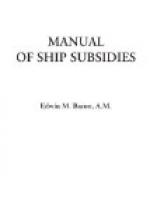The first effect of this law was to stimulate the organization of a number of new steamship companies, and to occasion activity in various ship-yards, foreign (English) as well as home, in building steamships for their service.[BR] Most of the domestic-built iron and steam tonnage produced during the law’s ten years’ term was of steamers.[BS] The tonnage of steamships increased from 278,000 tons in 1880 to 500,000 tons in 1890. Of this increase more than three-fifths were represented by vessels bought in other countries.[BT] The results of the navigation bounties are shown in official statistics covering the years 1882-1890. During this period iron or steel French-built ships earning these bounties increased from 159,714 tons to 190,831 tons, gross tonnage; while wooden or composite tonnage decreased from 150,233 tons to 57,068 gross. Foreign-built iron or steel tonnage earning the bounties increased from 43,787 tons to 91,170 tons, gross; and wooden or composite tonnage increased from 1,220 tons to 9,799 tons, gross.[BS] In 1891 the law which had then reached its limit of ten years was extended for two years. Doubting its renewal shipowners had sometime before ceased to increase their fleets.[BS]
These results were variously pronounced unsatisfactory, and a revised or a new law was called for, with more and higher bounties. Owners of wooden sailing-ships were especially clamorous for larger benefits. They argued that sailing-ships being much slower than steamers should therefore receive higher mileage subsidies in order to compete on equal terms with steamships.[BU]
A new law was enacted in 1893 (January 30). This act cut off bounties to foreign-built ships, and granted increased construction premiums. The construction subsidies were again declared to be given as “compensation for the charges imposed on shipbuilders by the customs tariff”; the navigation bounties, “by way of compensation for the burden imposed on the merchant marine as an instrument for recruiting the military marine.” The construction subsidies were not to be definitely earned till the ships were registered as French; and by ships built in France for foreign mercantile fleets, not till they had been delivered. The navigation bounties were accorded to French-built ships, of more than 80 tons for sailing-ships, and 100 tons gross for steamers, engaged in making long voyages and in international coasting; and were limited to ten years. They were based on gross tonnage per thousand sailed miles. To merchant steamships built in accordance with plans approved by the Navy Department, the rate of fifteen per cent above the regular navigation bounty provided in the law of 1881, was increased to twenty-five per cent. All ships receiving the navigation bounty were subject to impressment in case of war.[BV]




